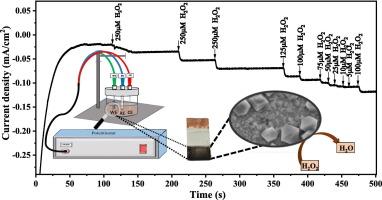Faceted nanostructured tellurium for non-enzymatic hydrogen peroxide sensing: Experimental and theoretical investigation
IF 4.1
3区 化学
Q1 CHEMISTRY, ANALYTICAL
引用次数: 0
Abstract
A new enzyme-free sensor has been designed on a copper substrate, utilizing faceted nanostructured tellurium (NSTe) to achieve highly selective and sensitive detection of hydrogen peroxide (H2O2). NSTe was effectively electrodeposited onto a copper substrate (0.36 cm2) from an aqueous electrolyte at ambient conditions. Growth kinetics and morphological changes at the underpotential deposition (UPD) region were analyzed using high-resolution field-emission scanning electron microscopy (FESEM). The phase purity of NSTe was analyzed using X-ray diffraction (XRD). The reactivity of prominent planes (102,111) obtained from XRD was compared theoretically. Elemental composition, along with the chemical state of the material, was identified from X-ray photoelectron spectroscopy (XPS). The electrocatalytic performance was studied using cyclic voltammetry (CV) and chronoamperometry (CA) in the phosphate buffer saline (PBS) of pH 7 to explore the non-enzymatic sensing properties of H2O2 by the NSTe thin film. A distinct reduction peak for H2O2 is observed when it interacts with the NSTe catalyst. Acting as a conductive bridge, NSTe enables direct electron transfer between the modified electron and the substrate, eliminating the need for an external mediator. The NSTe film, deposited at −0.013, −0.015, and − 0.02 V, exhibits sensitivity of 1177.14 ± 0.06, 1791.43 ± 0.11, and 1030.00 ± 0.04 μA mM−1 cm−2 towards H2O2, respectively. The highly sensitive electrode exhibits a wide linear detection range of 1.25 μM to 5 mM for H₂O₂, with a correlation coefficient of 0.978 and a response time of less than 6 s. The adsorption behavior and subsequent decomposition of H2O2 to water and oxygen were examined using theoretical methods. The developed sensor possesses good selectivity, stability, and reproducibility, which makes it useful for practical applications.

用于非酶促过氧化氢传感的面形纳米结构碲:实验和理论研究
在铜衬底上设计了一种新的无酶传感器,利用纳米结构碲(NSTe)实现了过氧化氢(H2O2)的高选择性和高灵敏度检测。在环境条件下,NSTe从水电解质有效地电沉积到铜衬底(0.36 cm2)上。利用高分辨率场发射扫描电镜(FESEM)分析了欠电位沉积(UPD)区域的生长动力学和形态变化。用x射线衍射(XRD)分析了NSTe的相纯度。从理论上比较了XRD得到的突出面(102,111)的反应性。通过x射线光电子能谱(XPS)鉴定了材料的元素组成和化学状态。采用循环伏安法(CV)和计时安培法(CA)研究了NSTe薄膜在pH为7的磷酸盐缓冲盐水(PBS)中的电催化性能,探讨了NSTe薄膜对H2O2的非酶敏感性能。当H2O2与NSTe催化剂相互作用时,观察到明显的还原峰。作为导电桥,NSTe可以在修饰电子和衬底之间直接传递电子,从而消除了外部介质的需要。在−0.013、−0.015和−0.02 V下沉积的NSTe膜对H2O2的灵敏度分别为1177.14±0.06、1791.43±0.11和1030.00±0.04 μA mM−1 cm−2。高灵敏度电极对h2o2的线性检测范围为1.25 μM ~ 5 mM,相关系数为0.978,响应时间小于6 s。用理论方法考察了H2O2对水和氧的吸附行为和随后的分解。该传感器具有良好的选择性、稳定性和重现性,可用于实际应用。
本文章由计算机程序翻译,如有差异,请以英文原文为准。
求助全文
约1分钟内获得全文
求助全文
来源期刊
CiteScore
7.80
自引率
6.70%
发文量
912
审稿时长
2.4 months
期刊介绍:
The Journal of Electroanalytical Chemistry is the foremost international journal devoted to the interdisciplinary subject of electrochemistry in all its aspects, theoretical as well as applied.
Electrochemistry is a wide ranging area that is in a state of continuous evolution. Rather than compiling a long list of topics covered by the Journal, the editors would like to draw particular attention to the key issues of novelty, topicality and quality. Papers should present new and interesting electrochemical science in a way that is accessible to the reader. The presentation and discussion should be at a level that is consistent with the international status of the Journal. Reports describing the application of well-established techniques to problems that are essentially technical will not be accepted. Similarly, papers that report observations but fail to provide adequate interpretation will be rejected by the Editors. Papers dealing with technical electrochemistry should be submitted to other specialist journals unless the authors can show that their work provides substantially new insights into electrochemical processes.

 求助内容:
求助内容: 应助结果提醒方式:
应助结果提醒方式:


